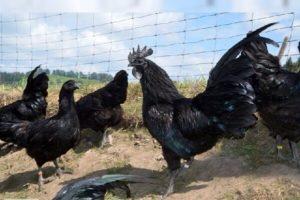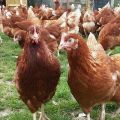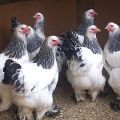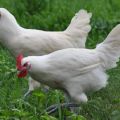Description and characteristics of Dutch chickens, white-crested breed content
Chickens of the Dutch white-crested breed are finicky birds. They do not tolerate cold well, have weak immunity, and occasionally need a haircut. Most often, the birds of this breed are given birth to admire their beauty. But, in addition to their attractive appearance, they delight with delicious meat, demonstrate good egg production. For successful maintenance, you should carefully study the characteristics of the breed.
Description and characteristics of the Dutch white-crested
In the 15th century, the common Dutch chicken did not have a white tuft. She was distinguished by good egg production, yielded tasty meat, and her plumage was painted black. But the breeders wanted to somehow embellish it. Therefore, they crossed chickens with representatives of the Polish white crested.
Appearance of the breed
The main distinguishing feature of the Dutch white-crested chicken is the white curl. The feathers cover the head evenly without falling over the eyes. The crest is like a snow globe.
Description of the appearance of Dutch chickens:
- small head without a comb;
- small brown eyes, head covered with red skin;
- the chest protrudes slightly forward;
- thighs of medium fatness, paws of a dull gray color;
- beautifully curved tail.
Black birds are more common, but as a result of selection, individuals with blue-white plumage and light gray (silver) plumage also appeared.

Productive qualities
In the process of work aimed at acquiring a decorative look for chickens, performance indicators decreased.
For meat
On average, the carcass of a Dutch white-crested cockerel weighs from 2.1 to two and a half kg, chicken - 1.5-2 kg. It is recommended to change the stock every 2 years. If the bird is older, its meat becomes coarse, fibrous.
Over the egg
A white-crested chicken begins to rush at the age of 6 months. In the first year, she gives 142-155 eggs, then the egg production rates decrease to 109-113 eggs. The shell is dense, white. Egg weight - 42-53 g.
Bird temperament
White-crested Dutch chickens are timid, shy, but curious. They do not get along with other breeds of poultry, but they almost do not fight among themselves. Find a common language with the owner, seeing a stranger hiding.
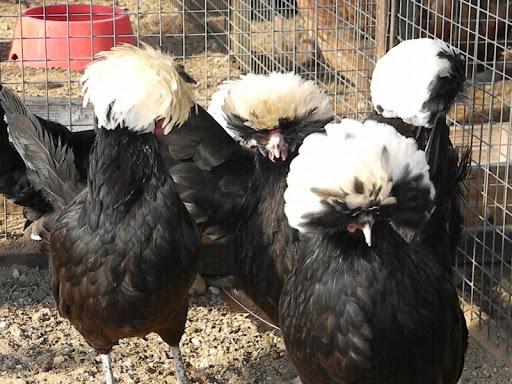
Main pros and cons
The advantages of Dutch breed chickens include:
- pretty appearance;
- impeccable taste of meat;
- moderate egg production.
Disadvantages of white-crested breed:
- do not get along with other breeds of poultry;
- have weak immunity;
- require special skills to care for them - it is necessary to wash their crest every week.
Dutch chickens don't rest during the day. They all the time scurry about the courtyard, run in search of midges and fuss.
Maintenance and care rules
Farmers who decide to have white-crested chickens should be patient. Keeping them is very difficult, since birds have increased requirements for caring for themselves.
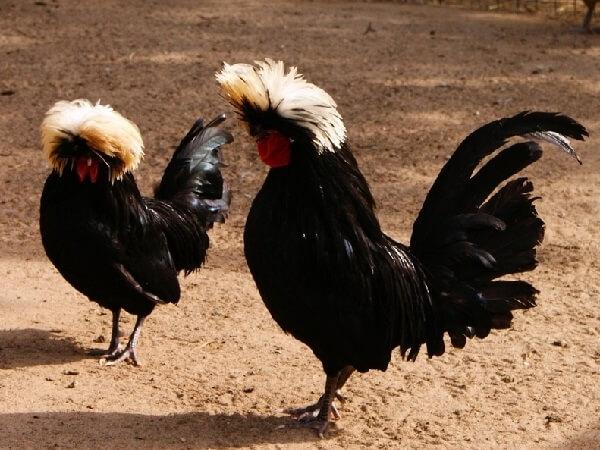
House requirements
Dutch chickens are quite active. They need freedom of movement. The area of the chicken coop is calculated according to the following scheme: per 1 m2 - 2-3 individuals.
The room should be equipped with high perch-perches, on which they can take a nap without crowding each other.
White-crested birds are not adapted to live in a cold room. In winter, they are not allowed outside, the temperature in the hen house is maintained at + 15 ... + 19 ˚С. The floor is sprinkled with slaked lime, and straw, shavings or sawdust are laid on top.
Place for walking, feeders and drinking bowls
Communication of Dutch chickens with other inhabitants of the courtyard should be minimized. Moreover, in the warm season, you need to provide them with the opportunity to walk on a fenced area. The feeders are placed on a raised platform. They must have lattice walls. Also, the bird needs to be provided with clean drinking water around the clock. The inventory is washed with special products every 2 weeks.
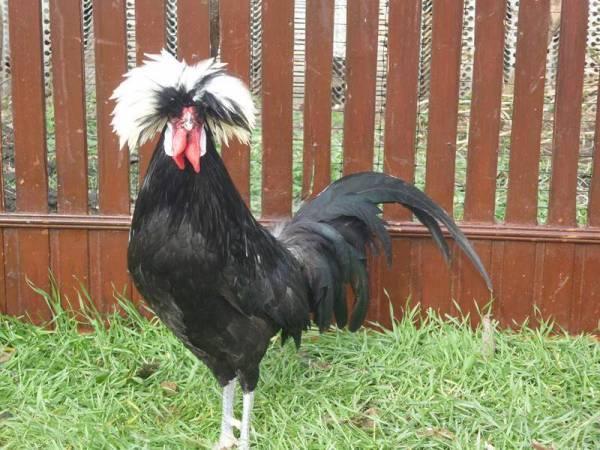
Molting and break of egg production
During the change of plumage, the chickens weaken, lose weight, stop rushing. Molting in white-crested Dutch women lasts 6-8 weeks, occurs in autumn. If there is not enough sulfur in their diet, they pluck feathers from a neighbor's crest.
Planned herd replacement
Birds of this breed live up to 5 years. Experienced breeders advise a planned herd change every 2 years. With age, the bird's immunity decreases, the risk of death from infectious diseases increases.
Feeding an adult herd
Important! It is unacceptable to feed white-crested chickens only with dry grain mixtures.

The Dutch women's digestive system is very weak and vulnerable. Feed is given three times a day. One meal (during the day) is a wet mash. In the morning and evening, the diet is:
- grains and legumes;
- boiled vegetables;
- in summer - fresh herbs, in winter - grass flour;
- fish or meat and bone meal, fish oil;
- vitamins, brewer's yeast;
- fermented milk products of low fat content.
In winter, the portion is doubled.
Breeding features
Breeding chickens of the Dutch breed begins when they reach sexual maturity (no earlier than 6-7 months of age). Oviposition is gradually improving over 3-4 months.
Instincts
The instinct of motherhood in hens is developed superbly. Almost 90% of crested whales successfully hatch offspring. Laying hens leave the nest once a day - to do their natural needs, stretch their legs, get some food and drink some water.

Caring for a hen
If the chicken spends all the time in the nest, drives away the owners with a loud cry, tries to peck, she is ready to hatch the chicks. To check, artificial eggs are placed under the hen for several days.
Rules for caring for Dutch white-crested blackbirds:
- prepare a place for incubation. The chicken should be transplanted into a separate, clean, dry, quiet, draft-free area. The box (nest) is covered with dry straw, sawdust. Selected eggs are laid under the hen at night and all at once. So the chicks will hatch at the same time. It is not recommended to disturb the bird. The chicken itself will repeatedly turn the eggs, so there is no need to help her;
- in the field of view, the brood hens set a feeder and a drinker, but so that she does not turn them over when she flies from the nest;
- if the chicken itself does not leave the nesting place to warm up and eat, it is carefully removed, the eggs are covered with straw;
- the walk should not last more than 20 minutes.At this time, they change the litter, revise the eggs, remove the damaged ones;
- For the first 5-6 days, it is not recommended to forcefully remove the brood from the nest.
During incubation, the bird must be checked for fleas and ticks.

Raising chickens
The hatchability of chicks in chickens of the Dutch white-crested breed is about 70%. Survival, even with good care, is low. More than half of the herd have been lost. The breed obtained by crossing 2 varieties of chickens has poor health and is sensitive to temperature changes.
Chick care rules:
- hatched chicks are taken away from the brooding mother, placed in a special cage;
- young animals do not have an excellent appetite, food for them must contain the necessary vitamins and microelements. Also, drugs are added to it that will prevent the development of infectious diseases;
- chickens are fed strictly on time, only freshly prepared mixtures are given;
- after each feeding, the dishes are disinfected;
- temperature of keeping young animals: + 26 ... + 28 ˚С, otherwise he will catch a cold and get sick;
- chickens are kept on a clean, dry bedding, wet can be a good "home" for pathogenic bacteria.
After the chicks get stronger and grow up, they are released into the common chicken coop. Then the hen will take care of them.
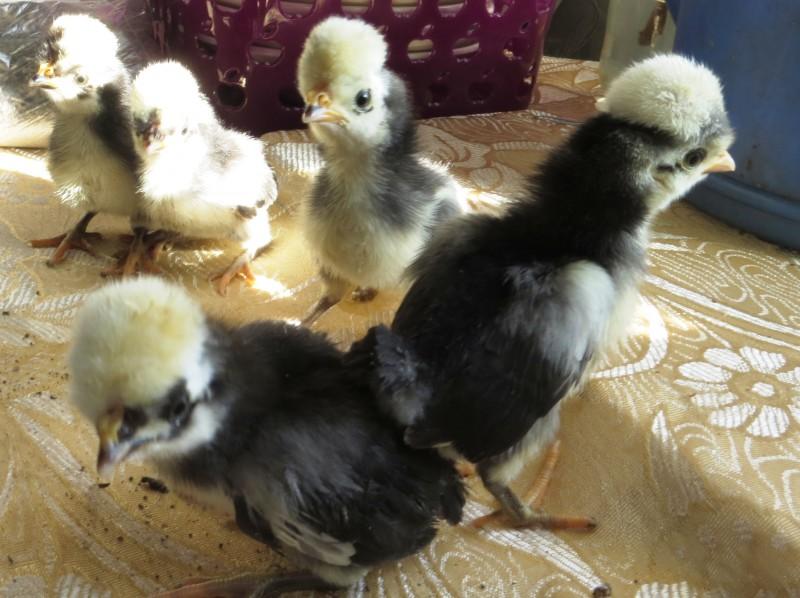
Frequent illnesses
Chickens of the Dutch white-crested breed are affected by infections, diseases from hypothermia, when the bird is exposed to rain on a walk, and parasites.
Ailments affecting birds and their symptoms:
| Diseases | Symptoms |
| Chicken mite damage | Decreased appetite, wounds, scratching |
| Ascariasis | Lethargy, diarrhea, loss of appetite |
| Salmonellosis | Indigestion, general weakness, lack of appetite |
| Laryngotracheitis | Wheezing, coughing, diarrhea, lack of appetite |
| Pterophagy | Plucking and eating feathers |
At the first signs of illness, infected birds should be immediately isolated from the flock. Despite the fact that chickens of the Dutch white-crested breed require increased attention, they continue to be in demand. Most often they are bred to participate in exhibitions.
